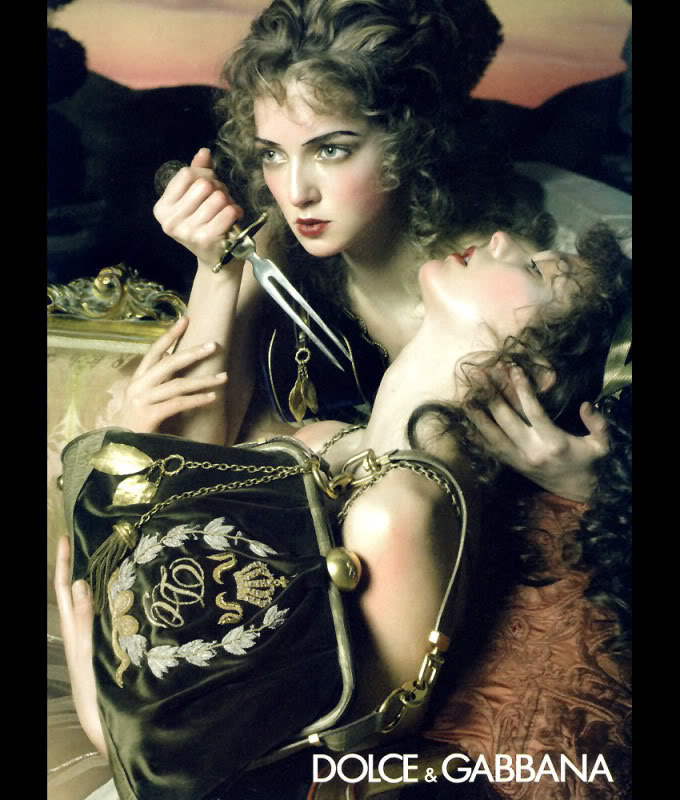Pictured here are two of the most representative of
themes of gender bending passivity and violence in all Dulce and
Gabbana advertisements. The first photograph comes from a
2006/2007 Renaissance-inspired campaign photographed by Steven Meisel,
which was attacked by the British organization the Advertising
Standards Authority for its excessive violence. It shows a woman
brandishing a forked knife at the throat of a passive female subject.
While the two subjects are women, they are shown in highly
hetero-normative poses. The woman with the knife can be seen in a
culturally masculine light. She is in control, strongly gripping
her weapon, and holding the head of her victim to show dominance and
precision. She stares off into the distance, emotionally
detached, and calculating, recalling Shakespeare's Lady Macbeth, who
was repeatedly described in masculine terms throughout the play.
Her victim represents all that is feminine -- passive, delicate,
and even as she is being attacked, reaching with her hand to toMuch her
attacker, as if to establish an emotional connection even in the face
of violence and possibly death. Clutched in her other hand is the
product the designers are attempting to sell -- a purse, a gendered
accessory. This creates an even stronger contrast between the
feminine and the masculine in this ad. Part of what is so
striking about this photograph is the aggression pictured on the
attacker's face. She is physically very feminine, but her violent
actions go against viewer expects of femininity. The victim, on
the other hand, is the one holding the purse, displaying all that is
virtuous in femininity -- including the right accessories.
The second picture is from a 2008
Dolce and Gabbana advertisement for a fragrance called "The One for
Men." Again, the picture shows only one sex, but can yet again be
read in terms of the dichotomous male-female relationship model.
The focal point is the man seated off-center, in something that
eerily resembles a gynecologist's chair -- an imagery that is
reinforced by the large spotlights that recall medical inspections.
With his legs and hands spread out, he is completely defenseless,
much like the victim in the first picture. The men standing
before him, by contrast, are in control. The man on the right
gazes upon his subject, as if examining him, and looks as if he is
about to remove his jacket. The man on the left of the chair
grips something behind the patient's leg and leans back, in motion.
The last man, to the farthest left, boldly gazes directly at the
viewer, as if to assert his masculine authority. Standing erect,
they counter-balance the passivity of the patient in the chair.
While in each of these images, there is only present one of the
sexes, the other is represented as if in an attempt to create the
complimentary harmony assumed to be inherent between men and women, and
here, disturbingly signaled through the gendered balance violence and
passivity. Notice that the fragrance this advertisement is
intended to sell is nowhere in sight. The provocativeness of the image
is apparently enough to generate interest in the label itself, and that
interest is what inspires the viewer to search for what they are
selling and to claim it as his or her own.
|

